Words: Carmela Fleury
THE FASHION DESIGNER
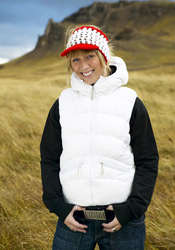
Heida Birgisdottir, 36, founder of Nikita Clothing, began designing clothes ‘for girls who ride’ with one store in Reykjavik, Iceland in 2000. Today Nikita is sold in more than 28 countries.
‘ I’m doing what I’ve always enjoyed doing – designing clothes – and I’m making a living out of doing it. I think Nikita’s success is down to having a clear vision of what I wanted to do and putting in a lot of hard work to make it happen.
My family, especially my parents, and friends always believed in me and never had any doubts that I could do what I wanted, as risky and optimistic as it must have sounded.
I started off with a snow and skate shop in 1995 with my boyfriend Rúnar (who also manages Nikita). Back then we used to go snowboarding every day or night that the mountain was open. And, when it was closed we’d be skating or surfing. We’d close the shop when the snow was at its best, or go surfing in the morning before opening the shop, even though it meant waking up at 6am and driving for an hour out of town and back.
Now I don’t get to go as often because I’m so busy with Nikita, but when I do go it’s usually to better places like Chamonix, St. Anton or Squaw Valley for a week of powder.
In this job, I get to meet a lot of very fun and interesting people who share our lifestyle of snowboarding, skating and surfing. I can go on a snowboard trip and call it “work” and that’s a serious perk of the job!
Snowboarding in powder is still on the top of my priority list. If you know the feeling, you know what I mean.
Inevitably it has been a lot of work starting an international clothing brand, so there are a lot of deadlines to meet, and deadlines create stress. Then again, I work best under pressure and I love to be busy, so I’m not complaining at all. I love what I do and I wish everybody was as lucky. The way we do business is pure pleasure, with amazingly fun, yet super-professional people we work with all over the world.
Snowboarding in powder is still on the top of my priority list when work allows. If you know the feeling, you know what I mean.
The feedback from all the ‘girls who ride’ around the world has been super positive and very important to me and really kept me going. The support from people around me who believed in me was also important.
I am now expecting a baby in December and I have no worries that my career will be an issue. It will just be fun!’
Heida’s tip: ‘I chose to do a snowboard season rather than attend a fine arts school and I truly believe that in the end, if your mind is not sure, gut instincts are the best way to make decisions. By that I don’t necessarily mean that people should always go for the flavour of the day, changing their mind constantly and blaming it on ‘gut feeling’, but I think we should listen to our heart at least as much as our brain. Don’t worry too much about the future – it will be here before you know it, so just focus on enjoying every minute until it arrives.’
www.nikitaclothing.com
THE EVENT ORGANISER

Tina Birbaum, 30, is a professional snowboarder and event organiser who set up girls-only snowboard contest The Roxy Chicken Jam. She is from Switzerland but lives in Chamonix.
‘I started snowboarding back in 1986 because I saw someone on the slopes with a snowboard and thought it looked incredible – what I’d been searching for since forever!
As I progressed and turrned pro, rather than just sitting back and waiting for things to improve, I really wanted to actively do something for women’ s snowboarding,. So I decided to set up the Chicken Jam – a women’s snowboarding jam in the US and Europe.
The girls are all stoked they finally have an event where they are the main attraction. It’s great that girls are getting more attention, because I had to fight against male domination all the time at the start of my snowboard career.
It can be very stressful handling so much responsibility with the Chicken Jam Being the organiser means doing everything: finding a location, finding the sponsors and finiancial backing, dealing with invitations and the press and much more. I sometimes wonder how I actually get it all done. I guess you just have to start somewhere and get on it – and it helps to be pretty good at talking!
It’s great that girls are getting more attention… I had to fight against male domination all the time.
The job is at its worst is when the weather is bad during the event, because there is absolutely nothing can do about it. But, as long as the riders are having a good time and enjoying it, I’m happy.
The atmosphere is always great. The girls have fun together and are so stoked for every other girl doing a new trick or having a good run. There’s been no competitive thinking yet. I think it’s much too serious at the guys’ events and the girls approach it with much more fun.
Generally I snowboard professionally and organise the events at the same time, so I have to just do things as they come up and whenever I have a bit of spare time.
My next project is to try to integrate some female freeskiers into the Chicken Jam and do a demo with them at the event.’
Tina’s tip: ‘If you want to be an event organiser, really get to know the snowboard or ski scene and make sure you have effective strategies to deal well with stress.’
www.chickenjam.com
THE SNOWBOARD PHOTOGRAPHER
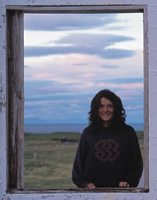
Natalie Mayer, 25, snowboard photographer had her first photo published in 2002. She works all over the world, but calls Jersey in the Channel Islands home.
‘I’ve always loved travel, people and adventures. Once I started getting interested in photography, it led to me working on the editorial side of snowboard magazines, and the rest just kind of happened.
I studied photography at university and started work at the bottom, becoming an intern at Onboard magazine. That lead to me being offered a position as editorial assistant on a UK snowboard magazine called Document, where I am now a senior photographer.
I worked hard at meeting the right people (this involved going to loads of parties) and eventually knew enough riders who wanted to shoot with me, and enough people willing to publish my photos.
The good times are so good that is really is easy to forget about the bad. I really can’t imagine what could be more fun than travelling with a group friends and documenting it at the same time, so that I have thousands of memories to keep looking back on. I love to read about a trip that I was on in a magazine, and know that I will have that memory preserved in photographs and writing, and sometimes video, for the rest of my life.
Photography wise, any job where the weather isn’t playing the game can be a nightmare. It kills the motivation of the riders, and can also play havoc with equipment, especially flashes. I hate the fact that I am reliant on a bunch of mechanical equipment. Having a shot in mind and not being to produce it purely cause of some little technical glitch is incredibly frustrating. But I’ve learned that it is all part of working in such extreme weather conditions, and the more I shoot, the more ways I find of getting round problems.
In the beginning I found it hard to approach snowboarders to ask if I could shoot with them. However, once I realized what a bunch of camera-loving show-offs snowboarders really are, I soon lost that initial shyness.
I do about seven months of travel, spread over the year. Surprisingly, the summer is also a pretty busy time for snowboard photography, with close-to-home summer camps on the European glaciers, and long haul trips searching for powder in the southern hemisphere. Wherever I’m shooting becomes my office for that day. Last week it was a rainy glacier in Norway, and right now it’s a crummy apartment in Les Deux Alpes in France.
THE FILM PRODUCER
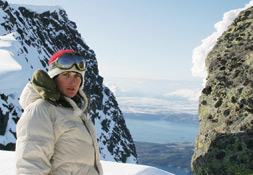
Josie Clyde, 28, started ChunkyKnit Productions in 2003 and launched the first all-girl snowboard movie Dropstitch.
‘From an early age I wanted to be either a photographer or a physiotherapist but at school they told me I couldn’t do either because I was no good at science. Well I eventually worked out you don’t need to be a scientist to mix a bit of developer and water together. I really got into taking photos when I was about 13.
I was working for a photo library that specialised in supplying ski and snowboard photography, and I started taking photos of British pro snowboarder Lesley McKenna, my childhood friend. I was doing bits and pieces of snowboard writing as well but I had quite a naïve approach to it all. I didn’t know anything about all the politics involved in the snowboard industry.
I asked Lesley why there weren’t any girls snowboard films yet as there seemed to be lots of guys’ films produced every year. She thought about it and decided the girls’ level of riding was about right to make a film. We spent about four months talking to people and feeling the ground and then in May 2003 we jumped right in and did our first trip so we could make a teaser to take to potential sponsors.
It’s great to feel like we are creating something new for snowboarding. And I’ve really enjoyed starting a new career – from photographer to producer -for myself. I think it has taught me that if you keep working at something and keep believing in it, then you can pull it off.
If you keep working at something and keep believing in it then you can pull it off.
Getting a good crew together and travelilng to a new place together is definitely one of the highlights of making a snowboard film.
It can be quite daunting because you invite the girls along and there is always a lot hanging on the terrain/snow/weather being good. If any of these three things are lacking then morale can slip quite quickly.
The lows of this job are injuries. Although every girl takes responsibility for what she does, I can’t help but feel a tiny bit responsible when one minute we have been filming and the next they are sitting there with a broken bone. It makes me sad because injuries damage the riders psychologically just as much as they do physically. And I can’t really deal with the thought of someone else in pain.
With our first film, DropStitch, we were on the road for about 150 days and with Transfer it had been about 120. Next year I’ll probably try and spend more time working from home instead of travelling so much. Although travelling is a definite perk of the job, but even with laptops and wireless internet, I can’t work properly when I am on the road. As a result when I come home it’s always a total nightmare trying to catch up with all the paperwork.’
Josie’s tip: ‘Take what you know and what you really enjoy and somehow turn that into a career. At least that way you know you are doing something you enjoy.’
www.chunkyknit.com
THE PROFESSIONAL SNOWBOARDER

Canadian Natasza Zurek, 25, has been riding professionally for seven years. She is sponsored by Burton, Nikita and Anon and lives in Vancouver.
‘I started snowboarding in 1992 because it looked like the greatest sport in the world.
I’d love to have as much control over the rest of my life as I do in snowboarding. My idea of absolute happiness is to be able to ride down the slope and do every trick I want when I want and how I want and land it every time.
When I first started riding I made a goal to become the best snowboarder that I could be. That hasn’t happened yet, so I keep me riding year after year. It will come close to happening once I’ve landed all the sevens.
Even though I ride so much, I get the fear a lot from a lot of different things. I have to just ask myself a question – is the fear really a valid, legitimate fear, or am I just being a pussy? If the answer is that it’s too dangerous or out of my league, then I won’t do it. But if I know I can do it but am just scared, then I will block the fear out of my head by thinking about rainbows, gold, and happy things.
I’ve never really thought it was any harder for a good female snowboarder to get recognition. That’s because there didn’t used to be many good girl riders out there, so whenever someone came along who could even do a backside 360, everyone would freak out and want to sponsor her. Nowdays the standard has got higher. Now, it takes a girl who can land a frontside 540 for everyone to start claiming her as the next big thing.
It’s fun to be at an all girl event and good that they are out there now, but it’s still good for the progression of the girls to ride with the guys.
The highs are great: learning new tricks and progressing; getting my first sponsor and my first photo in a magazine was very special and winning the US Open halfpipe in 2000 and 2001.’
Natasza’s tip: ‘Always remember why you started snowboarding in the first place.’
THE TEAM MANAGER

Steffi Hager, 26, is one of the few female team managers, working for snowboard brand, ThirtyTwo Europe. She is based in Basel, Switzerland.
‘I always wanted to get a job where I could meet a lot of new people, travel a lot and didn’t have to sit in the office all day, all year long.
I started working for Sole Technology (which make Etnies, es, emerica and 32 snowboard boots) as a receptionist at a trade show and helped out at their skate contests in Europe while I studied American Culture Studies.
As a female team manager, it was sometimes hard to get team manager passes for all the contests – most people thought I was just a groupie who just wanted to get a chance to hang out with the riders. Most people were surprised when they heard what I did, but in a positive way and I have a good relationship with a lot of people who do the same job that I do. As a woman, I don’t think I have any advantages, but there’s definitely no discrimination either.
It was hard to get team manager passes – most people thought I was just a groupie.
The main part of my job is helping out my riders however I can, sending out kit, dealing with contracts, trying to get them interviews and coverage, get them on the list of invitational contests, writing a team report every month and so on. And then there’s a lot of other stuff I have to do like getting in touch with magazines and sending out samples to them. I also have to help organise our skate contests, help out with trade shows, work together with our distributors on contests and go on tours with the skate team. That’s the best thing about this job – I get to travel and snowboard a lot.’
Steffi’s tip: ‘Accept that you may have to start with little jobs, get to know the right people, be open-minded and don’t be afraid of working long hours. Speaking a couple of languages makes it a lot easier, but if you want to get rich, you should look for another job.’
THE PR MANAGER
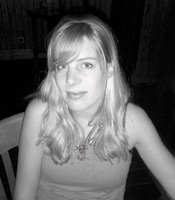
Birgit Gruber, 28, is European PR coordinator for Burton snowboards and is based in Innsbruck, Austria.
‘I started snowboarding when I was 15, at the same time as all my friends. So I had a passion and love for the sport already, before I got involved work-wise. I got involved in the snowboard industry in 1997, when I started to work for the International Snowboard Federation (ISF). A friend of mine told me about that job and thought it would be something I’d like. So I called, had my job interview the same day and started to work there the day after that. From that moment on I was completely hooked with the snowboarding world. It’s so much fun working in and for the sport you love most.
It’s hard to describe a day here at Burton because every day is so different and there is always something you don’t expect at all. In general I’m taking care of all PR aspects, which means supplying media with information about our products, riders and events. It also means a lot of travelling, be it to certain events like the Burton European Open or US Open or the Burton World Tour. It’s also about organising interviews when riders are available in Europe or getting Jake (Burton) into certain media. It’s about hooking up opinion-leaders with Burton gear and it’s about making sure the Burton message gets across the way we want it.
The highs are definitely being able to be part of the development and progression of snowboarding. It’s unbelievable how riders push the limits year after year. It’s great watching riders growing up from a rookie to a superstar. It’s amazing to see how events step it up year by year. And still, the most important thing about snowboarding is, and will always be, fun and friendship!
There are not really any lows. I pretty much love everything about the job I’m doing.
I’m really happy that finally female riders get the respect they deserve for what they do because they are pushing the sport same way as the guys do. I’ve been waiting for it to happen for a long time. Also at Burton, the Womens’ Initiative is a big one for us, which really stokes me out. It’s great to see magazines like Cooler popping up which are especially for the riding girls out there. Finally people realise the potential of women in snowboarding, and we have a louder voice than we have ever had before.’
Birgit’s tip: ‘Work hard, really hard, but don’t lose the fun.’
THE COACH
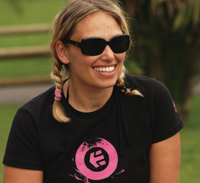
Marika Borg, 39, mother of two and MD of Girlie Productions which runs the surf , skate and snowboard Girlie Camps. She lives in Hossegor, France.
‘When I was younger I always spent my summers in the Mediterranean ocean. I started windsurfing and was hooked to being on a board and, consequently, later on in my life I fell in love with snowboarding and surfing.
My experience from the Battle snowboard event (which I used to organise) was a tool that we could use to move forward fast and get our message out. But I wanted to start the Girlie Camps because of my own experience through the years of surfing and snowboarding with my guy friends. It was difficult to find girls that wanted to go over the weekends. So that meant I rode by myself a lot, which was pretty boring. Fifteen years ago, I created an association for windsurfing girls in Sweden. We got together four times a year and it was so cool to meet other girls who also had a big heart for surfing. I think girls have a different way of learning and riding together it is a lot more relaxed and not so serious.
I can’t do anything unless I truly believe in it. I’m passionate about boardsports and get so happy every time I am out riding.
At the beginning, in 2003, we only had two Girlie snowboard camps in Sweden. This year there are 11 in various countries around Europe. I can’t do anything unless I truly believe in it. I’m passionate about boardsports and get so happy every time I am out riding. And I always thought that there should be something for girls out there. But I didn’t have a clue how it would work out because it was a very big task to start to communicate with the whole of Europe with all the languages and cultures. I didn’t have any expectations. I think if you are an entrepreneur, you just throw yourself into it and deal with it.
Burton was the first sponsor to step in and were really supportive and believed in my company directly. Straight after that, we signed with Etnies shoes and Roxy. Also Dakine has just signed us now. I have had the great opportunity to work with the most professional and incredible people in the industry and that has been very important to us because it has given our camp credibility.
The highs are definitely when I am paddling out in the water in the line up, or when I am on top of a mountain with the girls. We all share such great memories.
Sometimes I have to stop to remind myself how lucky I am. The lows are definitely when I come back from the camp and I have 500 emails to answer..’
Marika’s tip: ‘If you really want to do something, you can. If you grow slowly and find the right people to work with then anything is possible.’
www.girliecamps.com
THE WRITER

Leah Stassen, 27, is senior editor for TransWorld Business, a snow/surf/skate industry magazine, in Oceanside, California.
‘Once I graduated from college, I knew I wanted to stay in the industry—I just wasn’t sure how. As I was scoping out the classified ads one day on TransworldSnowboarding.com I saw a new listing for the Associate Editor position at TransWorld SNOWboarding Business. With a little luck, timing, a few skills, and some persistence and confidence was offered the job.
The day-to-day aspects of my job are all over the map. I’m responsible for all of the snowboarding content, the majority of the women’s content, and a lot of our columns. That means I’m coming up with story ideas, writing stories, working with freelance writers, and editing features and items that will appear in the magazine. All of this involves tons of email and phone calls. I also shoot many of the photos that appear in the articles I’m responsible for.
In the winter it’s a little different as I hit the road and start heading to the trade shows, contests and shops around the country. I love that I get to write about and follow what’s going on in snowboarding, a sport that I still get stoked about every year, even after 15 winters of riding. I like working in such a fun industry, where people are totally in tune with the lifestyle of our sports, where going on a snowboard trip is a “business trip”. Sometimes it’s hard to have your favorite hobby become your work. There are days where I’m in an amazing location, working, and riding, and I am bummed because I haven’t been home in forever and I just want to go snowboarding or surfing with my fiancé.
Also, working in the media and on a constant deadline adds an interesting sort of pressure to every situation. There are times when I’d love to go to an event and just hang out, enjoy it, watch the festivities, and get insanely crazy at the parties. But, I’m always there to record what’s happening, to share it with others, and to make sure that people can access that information as soon as possible. Often that mean’s I’m skipping the fun after a trade show or contest, remembering that I’m working, and getting to my hotel room to write something and get it posted on our website. For every girl in front of the camera there are tons of girls working super hard beyond the gaze of the lens.’
Leah’s Tip: ‘While people de-emphasise the importance of a degree, for me it was another check in a box that meant I had proper skills to become a writer. Having a degree – in anything – shows that you have the patience and persistence to finish a task.’

